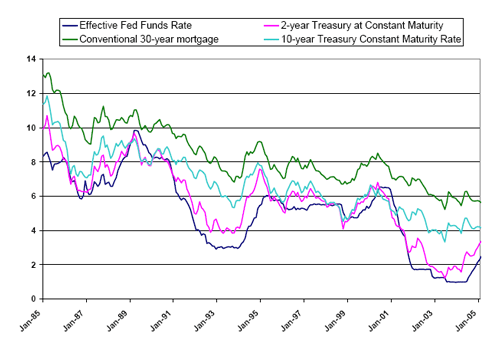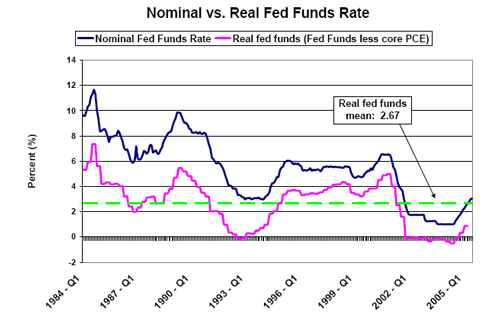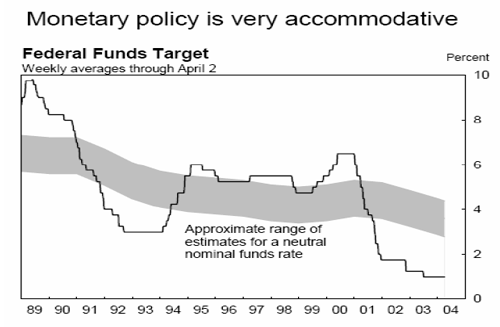Your question is quite relevant to monetary policy today. In a sentence, a so-called “neutral” monetary policy, also called the “natural” or “equilibrium” rate, is the federal funds rate rate that neither stimulates (speeds up, like pushing down the gas pedal on a car) nor restrains (slows down, like hitting the brakes) economic growth. What does this mean?
What is the federal funds rate?
You may know that the federal funds rate is the interest rate that banks charge each other for overnight loans. It also is the interest rate that the Federal Open Market Committee (FOMC) targets when it meets eight times each year to make monetary policy decisions, which are designed to achieve the Federal Reserve’s goals of maximum employment, stable prices, and moderate long-term interest rates. 1
How does the fed funds rate compare to other interest rates?
Though the FOMC sets only short-term rates, movements in the federal funds rate are a benchmark for many other interest rates in the economy. As shown in Chart 1, most interest rates tend to move fairly closely in line with the fed funds rate. This is because the FOMC’s decision to raise or lower interest rates may act as a signal to financial markets about the health of the economy, concerns about inflation expectations, or both—thus changes in the overnight interest rate may affect changes in longer term securities. Still, it is important to remember that the Fed is only able to directly influence the federal funds rate, a short-term interest rate.
Chart 1 –Interest rates have tended to move together over time 2

The Neutral Rate
At what rate or range of rates does a change in the federal funds rate go from being low enough to be “accommodative” to being high enough to dampen economic activity? The answer is the neutral rate, often defined as the rate or range of rates consistent with full employment, trend growth, and stable prices. An economy in this state presumably wouldn’t need to be stimulated or slowed by monetary policy.
The neutral rate is often explained using the story of Goldilocks searching the home of the three bears; as Janet Yellen, president and CEO of the Federal Reserve Bank of San Francisco, recently observed in an interview in The International Economy Magazine, “monetary policy should be at neutral only when economic conditions are ‘just right’.” 3
How is the neutral fed funds rate calculated?
Defining the neutral rate proves to be much simpler than calculating it, as noted by Federal Reserve Bank of San Francisco Economist John C. Williams in his October 2003 Economic Letter, “The Natural Rate of Interest.” The neutral federal funds rate has no explicit value—it is an estimate, and as economists famously disagree on many issues, they can also disagree on the range in which the neutral rate falls, and how it might change over time.
Economists often describe the neutral rate by talking about the real federal funds rate— that is, the nominal fed funds rate minus a measure of inflation (such as the Personal Consumption Expenditures Price Index). Chart 2 displays both the real and nominal rates for recent decades. Calculating the real fed funds rate allows you to look at changes in interest rates in terms of purchasing power, or without the effects of changes in inflation. For additional information on the difference between nominal and real interest rates, see the August 2003 Dr. Econ.
Chart 2 – The nominal and real fed funds rate

What is the neutral rate in 2005?
In her interview with The International Economy Magazine Dr. Yellen also noted estimates of the neutral ranges of both real and nominal fed funds rates:
“Research suggests that the neutral real rate is probably somewhere in a 1.5 percent to 3.5 percent range. To get to a neutral nominal rate, we have to add in expected inflation. That probably takes us to a neutral nominal range of around 3.5 percent to 5.5 percent at this point.” 4
In addition, most economists agree that the neutral rate is not constant over time. Just as economic conditions are constantly changing, so does the monetary policy direction at a given time that would be consistent with neutrality. The factors that determine the neutral range are complicated and varying; as Dr. Yellen further noted in the same interview:
“The neutral real rate itself depends on a variety of factors – the stance of fiscal policy, the trend of the global economy which shows up in our net exports, the level of housing prices, the equity markets, the slope of the yield curve, or the term premium built into the yield curve. So it changes over time.” 5
A chart created by San Francisco Fed Economist Glenn Rudebusch from the April 2004 edition of FedViews, 6 the San Francisco Fed’s online forecast, provides a nice illustration of how the neutral rate may have changed over the period from 1989 to April 2004. As the chart’s title indicates, monetary policy was considered quite accommodative in April 2004; the federal funds target rate was set at one percent, far below the estimated neutral range. 7
Chart 3 – One estimate of the neutral rate over time

How close are we today to being “neutral”?
On June 30, 2004, the FOMC voted to raise the fed funds rate by 25 basis points to 1-1/4 percent —after holding it at 1 percent for a year. At each successive FOMC meeting (at least up to the August 2005 publication date) the FOMC continued to raise rates by 25 basis points. You may have noticed that the FOMC statements released after each of these FOMC meetings stated, “the stance of monetary policy remains accommodative.” Over much of the year, the Committee has also indicated that accommodation can be removed at a pace that is “likely to be measured.”
Though many economists estimate that U.S. monetary policy is currently near the neutral range, Fed Chairman Alan Greenspan has acknowledged how challenging it is to know where the neutral rate truly lies:
“It’s very difficult to know where that so-called neutral rate is. But we probably will know it when we are there because we will observe a certain degree of balance, which we had not perceived before, which would suggest that we are somewhere very close to where that is.” 8
“Essentially you get down to the point that we will not know it until we’re actually there.” 9
Endnotes
1. For more information on how open market operations effect the federal funds rate and the economy, please see the chapter, “How the Fed Guides Monetary Policy,” in the Federal Reserve Bank of San Francisco’s 2005 publication, “The Federal Reserve System in Brief.”
2. For additional discussion on the relationship between discount rate and mortgage rates, see Ask Dr. Econ, June 2002.
3. “The Yellen View.” The International Economy Magazine (Spring 2005).
6. Fedviews is not archived. Only current month is available.
7. For additional discussion on how the neutral rate might be calculated, see Williams (2003).
8. “Greenspan: Rates Will Rise at ‘Measured Pace,’” Financial Advisor News, June 9, 2005.
9. “Yuan revaluation won’t aid U.S. as thought,” MSNBC.com, May 20, 2005.
References
“Federal Reserve System in Brief.” 2005. Federal Reserve Bank of San Francisco.
“U.S. Monetary Policy: An Introduction.” 2004. Federal Reserve Bank of San Francisco.
FedViews. Federal Reserve Bank of San Francisco.
Williams, John C. 2003. “The Natural Rate of Interest.” Federal Reserve Bank of San Francisco, Economic Letter. Number 2003-32, October 31, 2003.
“Greenspan: Rates Will Rise at ‘Measured Pace’”, Financial Advisor News, June 9, 2005.
“Yuan revaluation won’t aid U.S. as thought,” MSNBC.com, May 20, 2005.